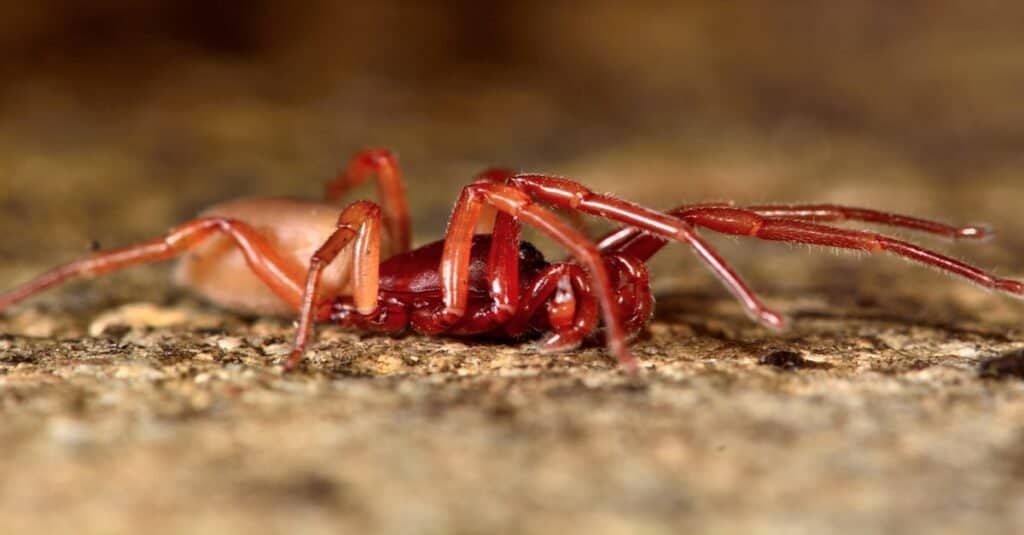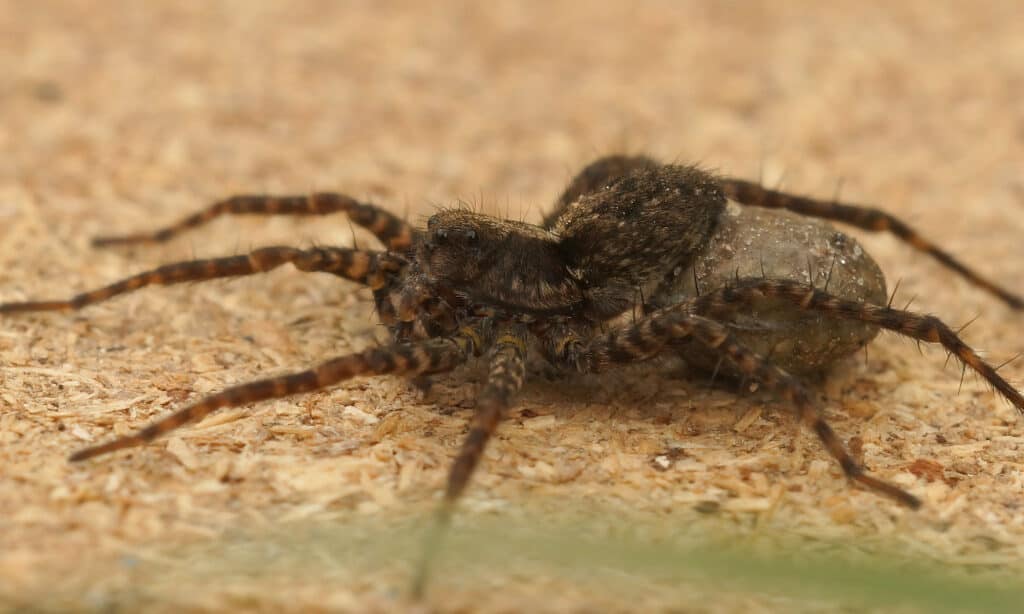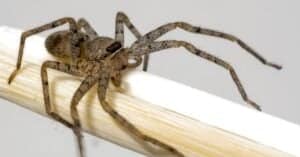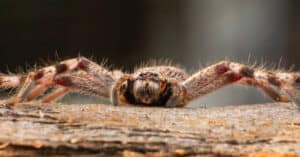It’s time to discover the top five largest, most dangerous spiders in Nebraska! This state is full of natural beauty and has a wealth of amazing animals that call it their home. But when it comes to dangerous spiders, Nebraska only has two that are truly hazardous to human health. However, it has its share of large spider species, too! This is Nebraska’s top five biggest spider species and the showdown for the most dangerous spider in the state!
Top Five Largest, Most Dangerous Spiders In Nebraska
There are the two most dangerous spiders in the United States! But which one is the most dreaded species in the state? And which spiders top the list for biggest spiders in Nebraska? Let’s find out!
5. The Woodlouse Hunting Spider

Woodlouse
spiders are ambush spiders commonly found in Nebraska.
©IanRedding/Shutterstock.com
Size: Up to 15 mm long
Habitat: Wooded areas, basements, outer walls, woodpiles
Danger To Humans: Not dangerous, but bites can be painful
Behavior: Reclusive, solitary, will bite if threatened
Physical Description: Woodlouse hunting spiders have six eyes instead of eight and have very large, disproportionate mouthparts. They have orangie-red legs and overall bodies, except for their yellowish-brown or grey abdomens.
Woodlouse Hunting Spiders In Nebraska
This species is one of the most common spiders in Nebraska and can be found in all parts of the state. Though their bright orange-red coloring may suggest this species is dangerous to humans, they aren’t considered dangerous to humans. To their prey, on the other hand, this spider is deadly! Instead of using webs to catch prey, they rely on ambushing their victims. Thankfully, their bite may hurt a human, but it isn’t dangerous!
4. The Dark Fishing Spider

The dark fishing spider in Nebraska can run across the water surface.
©iStock.com/JasonOndreicka
Size: Up to 25 mm long
Habitat: Near bodies of water such as streams, lakes, or rivers.
Danger To Humans: No danger; bite is like an insect sting.
Behavior: Shy and skittish, bites if threatened
Physical Description: Dark fishing spiders are mottled shades of dark to medium grey with dark banded leg markings. Additionally, the species’ key identifying marking is the W-shaped markings on the abdomen.
The Dark Fishing Spider In Nebraska
This species is commonly found throughout the central and eastern regions of the United States and is a common spider all over Nebraska. Classified as nursery spiders, this species only spins a web to hold an egg sack. As the name suggests, dark fishing spiders use the hairs on their long legs as lures to catch insects or small fish. They rarely bite humans and prefer to run from us. However, they will bite if cornered. Luckily, their bite is not dangerous and hurts less than a bee sting!
3. The Tiger Wolf Spider

The
tiger
wolf spider is one of the largest commonly found spider in Nebraska.
©HWall/Shutterstock.com
Size: Up to 25 mm long
Habitat: Forests, wooded areas, and human dwellings throughout the eastern U.S.
Danger To Humans: Not dangerous to humans, but bites are often painful
Behavior: Moderately aggressive, will bite if threatened
Physical Description: Female tiger wolf spiders are larger than males, and are black overall with grey abdomens and striped, brown markings. Males are smaller, lighter in color, and can be yellow, light, or dark brown overall with similar markings. Wolf spiders have large and powerful legs, heavy bodies, and four pairs of stacked eyes.
Tiger Wolf Spiders In Nebraska
This species can be found all over Nebraska as a common house spider. Wolf spiders thrive in a variety of habitats and do not spin webs to catch prey. Instead, they are ambush hunters that use their strong legs to attack smaller insects. While venomous, their bite is not deadly and rarely requires medical treatment. However, the bite does hurt quite a bit, so watch out!
2. The Brown Recluse Spider

The brown recluse is the second most dangerous spider in Nebraska.
©Nick626/Shutterstock.com
Size: Up to 20 mm long
Habitat: Human dwellings in Southern/Midwestern U.S.
Danger To Humans: Necrotic venom that causes serious injury if left untreated.
Behavior: Reclusive and solitary, but will bite if provoked or threatened.
Physical Description: This species can be identified by its overall translucent light brown overall coloring and the distinct “violin shaped” marking on the cephalothorax. Additionally, unlike most spiders, the brown recluse only has six eyes rather than eight.
The Brown Recluse In Nebraska
This species is primarily found in the southeastern regions of Nebraska. However, due to its preference for cramped and dark locations, it tends to end up in shipping containers or vehicles. Therefore, this species pops up in unexpected places quite often. Brown recluse species are one of the most dangerous spiders in North America. Its bite contains necrotic venom that breaks down vascular walls, causing serious injury and illness. While dying from a recluse bite is rare, vomiting, muscle aches, and skin necrosis are common.
1. Black Widow

Black widow spiders are the most dangerous spider species in Nebraska.
©Sari ONeal/Shutterstock.com
Size: Up to 16 mm long
Habitat: Multiple habitats, prefers dark, isolated locations like cellars or sheds
Danger To Humans: Highly dangerous venomous bite that can kill in some cases. Quick medical attention is recommended. Females account for most recorded bites.
Behavior: Shy, timid, but will bite if threatened
Physical Description: Black widow spiders are one of the most easily recognized species in North America. They are identified by their glossy black overall coloring and signature hourglass markings. Despite common misconceptions that this hourglass is always red, white, or orange are also common!
Black Widows In Nebraska
There are 32 known species of widow spiders, and not all of them are black! In Nebraska, the western black widow species is common throughout the state. Bites are generally due to accidental contact but can be deadly without medical treatment. Common reactions to black widow venom are fever, sweating, vomiting, swelling, and infection. Though this species has a bite that can kill, it rarely bites humans!
The photo featured at the top of this post is © Nick626/Shutterstock.com
Thank you for reading! Have some feedback for us? Contact the AZ Animals editorial team.







